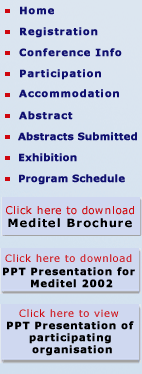| Name |
Pradeep Pathak |
| Title |
Predictive Data Mining in Healthcare |
| Authors |
Pradeep K Pathak and S Selvan |
| Institution |
Department of Information Technology,
PSG College of Technology,
Coimbatore Tamil Nadu
641 004 |
| Abstract |
This paper discuss about the integration and mining of electronic information (that makes practice perfect) from multiple sources and advanced integration testing (to test the interoperability of the systems). Health Services mines its data to predict what services it will need in the future based on utilization patterns from the past. If we can reduce variation around the best practice, we can improve the quality of care and the outcomes. Rapid access to databases such as formularies, drug references, and other decision-making support tools, improves the quality of care. Computerization of health care information offering new, viable opportunities to improve and streamline the health care delivery system and presents new challenges to individual privacy interests in personal health care data.
Another big issue is the reliability of the data. Both doctors and hospitals have long contended that most data on patient mortality aren't properly adjusted to reflect how sick patients are. Analysts projections claim to have the potential to reduce medical errors, increase competitive advantage, save money, enhance productivity, improve workflow and enable patients and practitioners in new ways. This comprehensive begins with the vision and promise of wireless, then drills down to provide practical application solutions including, access issues, integration and the convergence of technology applications that examine what works and what doesn’t.
Information Capture and Report Generation
The need for sharing health information among authorized health practitioners is hindered by inadequate documentation methods. Handwriting is often illegible, and varying terminologies represent different meanings to different practitioners. Lack of a universal structure of patient information makes it difficult to find relevant information in a record created with free text or from another organization.
In this part, we describe a set of “Essential Principles of Healthcare Documentation” to enhance quality of care, reduce medical errors, and diminish documentation costs.
Healthcare documentation has two parts: information capture and report generation.
Information capture is the process of recording representations of human thought, perceptions, or actions in documenting patient care, as well as device-generated information that is gathered and/or computed about a patient as part of health care. Typical means for information capture are handwriting, speaking, typing, touching a screen, or pointing and clicking on words, phrases, etc. Other means include videotaping, audio recordings, and image generation through x-rays, etc.
Report generation, i.e., the construction of a healthcare document (paper or digital), consists of the formatting and/or structuring of captured information. It is the process of analyzing, organizing, and presenting recorded patient information for authentication and inclusion in the patient’s healthcare record. It focuses on six methods, i.e., handwriting, speech, direct computer input, document imaging, device capture, and clinical imaging, as well as their hybrids. The evolution from handwriting to electronic healthcare documentation is concurrent with a transition from free text to structured and interactive text.
Many steps must be taken to create systems and policies that make healthcare documentation more effective for quality health care. The key principles are that:
1. Unique patient identification must be assured within and across healthcare documentation systems.
2. Healthcare documentation must be:
2.1 Accurate and consistent.
2.2 Complete.
2.3 Timely.
2.4 Interoperable across types of documentation systems.
2.5 Accessible at any time and at any place where patient care is needed.
2.6 Auditable.
3. Confidential and secure authentication and accountability must be provided.
Applications of data mining in the health-care industry are widespread. One way data mining is helping health-care providers cut costs and improve care is by showing which treatments statistically have been most effective. For example, once hospital administrators recognize that stroke patients are less likely to develop respiratory infections if they can swallow properly, they can educate their physicians and institute a standard policy to identify and provide therapy to those who have difficulty swallowing. Along the same lines, outcomes measurement also lets care givers identify people statistically at risk for certain ailments so that they can be treated before the condition escalates into something expensive and potentially fatal. Fraud detection is yet another outcomes analysis application. When administrators compare the volume of lab tests ordered by physicians, evidence that a doctor is ordering too many unnecessary tests would leap off the page. An allergy sufferer who has tried a variety of treatments without success, for instance, might be receptive to alternative herbal or acupuncture treatments.
|
| Presentation Type |
Power Point Slides |
| Requirements |
Data Projector |


